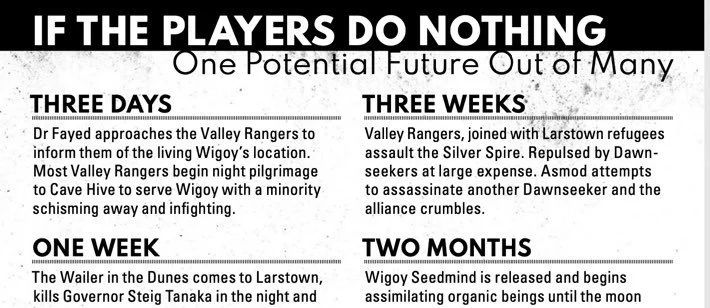Calendars, Not Just Maps
Because visual media is easier to digest, maps tend to predominate TTRPG adventure design. Consider your favorite one-page dungeon; it probably has a map that looks rad as hell! The visually striking maps draw you in. Fantasy books rarely begin with a detailed calendar, but often open up to a Tolkienesque fantasy map. But the focus on PLACE can sometimes overshadow another important element for adventures: TIME.
The above image is from Desert Moon of Karth, and it was what made the adventure really feel alive to me. The author recently posted on their blog about the importance of time/events, with some ideas on procedurally generating these elements. And there is so much you can add to the campaign this way. Some friends recently recommended having players select a “birthday” for their characters and put that on the fictional calendar, which I can see really drawing players into the fiction of the world in such a small way.
Maps are really helpful for location-based adventures, whether it’s a dungeon map or a wilderness hex map. But a location is comprised of both time and place. So while a keyed map tells you what the location is like, it is static. An ogre is in this room, a naga in that one, etc. But by pairing a map with a calendar (and a random encounter table, which also represents TIME), you make the dungeon dynamic. The same is true for wilderness adventures too. In Neverland, for instance, the world (and, more importantly, the giant crocodile) operates in predictable routines on both an hour-by-hour and week-by-week basis, which players can use to their advantage.
The righthand page does a good job of visually representing time.
A calendar is most useful if it describes what will happen without player intervention. This is the best because it doesn’t assume any player actions. My least favorite is a timeline that assumes players will do this or that just because that’s what the designer expects. That’s not a calendar; it’s a script, and TTRPGs work best when they’re unscripted.
To that end, in my own location-based adventure, Barkeep on the Borderlands, I’m thinking carefully about how I can use time to make the Keep and its various pubs dynamic. Part of that is with a calendar, part it with random events. At least one bar will have a random encounter table where certain disastrous events become more likely with passing time (likely using context-sensitive encounter tables, among other little tricks of design). And all of this does something just as important as making the world feel dynamic. It makes time a resource that the players must make decisions around.
A map is the casing for an adventure, factions are its gunpowder but you need a calendar to turn a site-based adventure into a ticking time bomb for players to de-fuse (or not!). Which is exactly what I’m planning Barkeep on the Borderlands to be.


